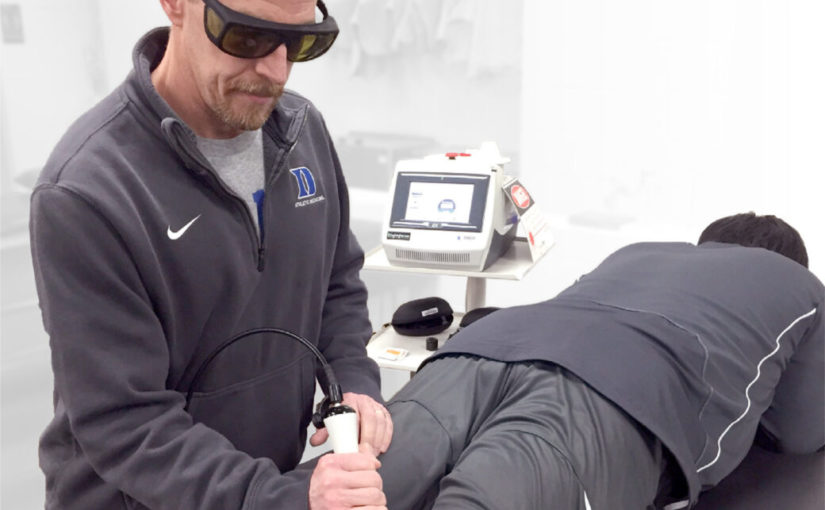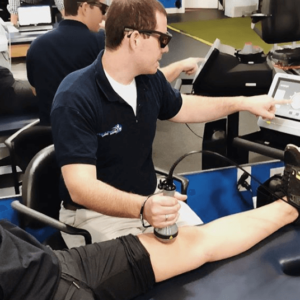Apr 30, 2021Laser Therapy: The Best Kept Secret in Recovery
What if there was a rehabilitative therapy that treated acute injuries better than ice; one that didn’t create chemical dependencies or require going under the knife? Is there something out there that can relieve the searing phantom pain felt by amputees or war veterans who’ve suffered years of back pain from degenerative disc disease by speeding up the body’s innate restorative process?
If you think a treatment like this exists only in the latest Marvel movie and not in the real world, may I formally introduce you to the best-kept secret in recovery: photobiomodulation (PBM), more commonly known as laser therapy.
 It is the use of specific wavelengths of light to stimulate the body’s natural ability to heal and is not only changing the way healthcare professionals approach treatment of various injuries but also helping trainers keep their athletes in the game.
It is the use of specific wavelengths of light to stimulate the body’s natural ability to heal and is not only changing the way healthcare professionals approach treatment of various injuries but also helping trainers keep their athletes in the game.
That sounds pretty amazing. But how does it work?
Well, the treatment uses red and infrared wavelengths that fall between 650 to 980 nanometers (nm). These wavelengths penetrate the skin and soft or hard tissues, and your body’s cells absorb the light energy and convert it into cell energy. Only dormant cells and tissues absorb the light energy, leaving the healthy cells unaffected. The lasers used during PBM are not like those used to perform surgeries or even those used by over-zealous James Bond villains. While surgical lasers use around 300 watts to cut through the skin, therapy laser devices use up to 28 watts.
The result gives your cells an energy boost, improves blood circulation, speeds up tissue healing, and can relieve general pain.
“Pain isn’t always a bad thing,” Dr. Phil Harrington, Summus Laser medical director and laser safety officer, said. “It’s an indicator that there’s a change in the body. So what laser therapy does is help speed up the stages of inflammation in a more efficient way by pulling various chemical messengers we’re able to complete that process.”
Depending on the injury, after just a few sessions the area is healed and the inflammation is gone, Harrington said.
That all sounds great, but what does all that mean for athletes?
Sure. Coping with pain can be frustrating, time-consuming and, if not dealt with properly, a risky experience. And even if dealt with properly — like, for example, back surgeries — there can still be complications or uncertainty around returning to past form. Instead of turning to prescription drugs — which are highly addictive — to mask the pain, or going under the knife, opting for non-invasive treatments first is always something to consider. That’s where laser therapy comes into play.
Studies and clinical experience demonstrate has stated that laser therapy has been proven to aid in the following conditions:
- Back Pain
- Muscle Strains
- Neck & Shoulder Pain
- Plantar Fasciitis
- Ligament Sprains
- Tendinitis & Bursitis
- Tennis Elbow
 “I was speaking with a head trainer for an MLB team and I was thrilled when he told me that nearly all of the guys coming up through the minor league system are asking for laser therapy. They don’t ask for ice anymore,” Dr. Harrington said. “Outside of a few of the more veteran guys, with any acute injuries, every player in the clubhouse is asking for laser therapy.”
“I was speaking with a head trainer for an MLB team and I was thrilled when he told me that nearly all of the guys coming up through the minor league system are asking for laser therapy. They don’t ask for ice anymore,” Dr. Harrington said. “Outside of a few of the more veteran guys, with any acute injuries, every player in the clubhouse is asking for laser therapy.”
While the R.I.C.E protocol has been the gold standard of treating acute injuries, the very nature of ice — serving as an anti-inflammatory — disrupts the body’s natural healing process, where inflammation is a key step in that process.
“Anything you do that suppresses inflammation is slowing down the rate of healing and lessening the quality of healing,” Dr. Harrington said. “By putting ice on acute injuries we are suppressing the inflammatory response and that’s why athletes have repeat injuries.”
He went on to add that he’s not the only person re-thinking the use of ice on acute injuries, even Dr. Gabe Mirkin, the developer acronym back in 1978, has done a 180-degree-turn and since eliminated the “I’ in R.I.C.E.
Okay. Now you have my attention. How do I get exposure to laser therapy for my athletes?
That’s where companies like Summus Medical Laser come into play. Having its products used in professional medical settings, including major league athletic trainer’s rooms, for decades, Summus’ laser systems allow for easy integration and top-notch training tools.
» ALSO SEE: Basketball Strength Training — Make Your Next Season the Best Season
Its Horizon Laser system, which debuted in October 2020, is equipped with four wavelengths — 650 nm (accelerates surface healing); 810 nm (increases ATP production); 915 nm (enhances oxygen delivery); 980 nm (improves circulation). And with its independent control, trainers can utilize any one of the preloaded 37,000-plus phased protocols, or create and save their own protocols. Training is tantamount to the company’s mission to raise awareness of laser therapy and the Horizon offers a number of guidance features.
“With tools like the Visual Guidance, which displays animated motion graphics of how to give treatments, and the preloaded protocols automatically adjust treatments as the healing process, we actually teach you how to give laser treatments,” Betsy Ferg, Summus’ Director of Marketing and Creative, said. “It’s a whole system.”
The future in recovery is here and it’s willing to walk you through the process.
“I’ve been in this business for 18 years and we were always preaching at all the conventions about this as an alternative to ice and tissue healing,” Dr. Harrington said. “Now it’s catching on, and I’m over the top thrilled about it.”



